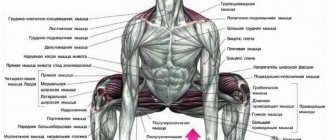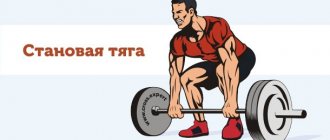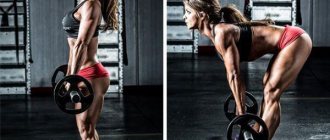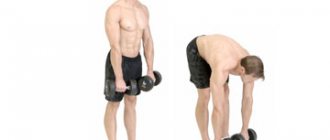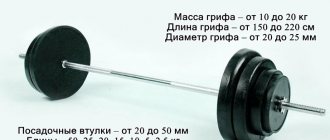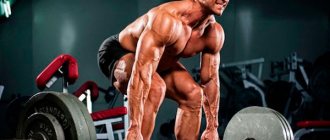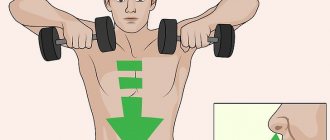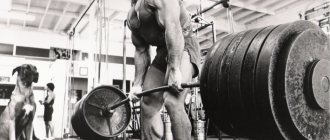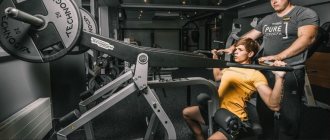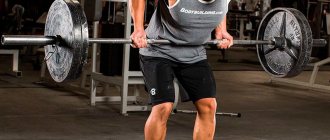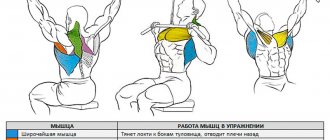The deadlift in bodybuilding is deservedly considered one of the best exercises that promotes the rapid gain of muscle mass and the development of physical strength. The fact has long been tested in practice that it is in principle impossible for a bodybuilder to achieve impressive amounts of muscle mass without deadlifting.
The main feature of this exercise is that when performing it, almost all large muscles in the spine, hips and buttocks are involved. In addition, deadlift is very close to human physiology , because each of us periodically has to lift various things.
If the above hasn't convinced you yet, try this exercise yourself. Definitely, no exercise machine will give you such a feeling of pumping up all your muscles!
Like any strength exercise, the deadlift has its own correct technique, and we’ll talk about it.
Deadlift "Tools"
Let's start with the fact that this exercise works in three directions:
- competitive traction;
- strengthening the muscles in the back;
- formation of the athlete’s frame.
Based on the directions, the main goals of the bodybuilder are identified:
- Gradual increase in weight on the barbell.
- Strengthening the rectifiers in the spine.
- Increases overall strength of the back muscles.
To achieve these goals, 4 types of deadlifts :
- in the style of " Sumo "
- in " Classical " style,
- «Deadlift»,
- traction “ From the plinths ” (plinths are stands for the barbell, bringing it to the knee level position).
The list of “hardware” for deadlift includes things familiar to every weightlifter: an Olympic bar (20 kg), locks and plates, plinths and straps, a weightlifting belt and chains, chalk or magnesium.
Deadlift and bodybuilding workouts
There is also a lot of debate about whether bodybuilders need deadlifts. Many coaches and athletes believe that the classic deadlift is more suitable for gaining muscle mass, as it involves all muscle groups of the body. This will help you achieve the best possible result. Some people believe that the sumo deadlift is better because there is no need to go through such a large amplitude. In addition, the leg muscles are more involved in the work, which reduces the risk of lower back injury.
If an athlete uses a large working weight, he increases the training volume, which will have a positive effect on progress. This is an important factor for bodybuilder training.
Errors
One of the most common mistakes when performing classic deadlifts is straight legs: in this case, there is a very large load on the joints. If the spine is not strictly vertical, displacement of the vertebrae and overstrain of the stabilizer muscles are possible. If the spine is rounded – “hump pull” – back injuries and pinched nerves are also possible.
When doing a classic deadlift, don't place your legs too wide—you should have one foot between them—don't lift the weight by abducting your pelvis, and don't leave your pelvis abducted as you straighten your body.
The main mistakes when doing sumo deadlifts are rounding the back when bending over the bar and leaning forward, as well as a large range of motion of the back.
When lifting heavy weights in the Romanian deadlift, there is a high chance of injuring the hamstrings. When moving down, do not put the weight on your shoulders so as not to injure your joints. Don't look at your feet, as this may disrupt your balance.
When lifting a barbell with a different grip, the axial load on the spine increases and the risk of injury increases. To reduce it, the position of the hands is changed with each approach. If your grip is weak, it is better to use wrist loops or belts instead of a different grip.
Deadlift Equipment
A conversation about deadlift would be incomplete without mentioning the current records in this movement. Deadlifts can be performed without equipment or with equipment. The question arises: what can be considered equipment? Overalls? Straps? Or even a belt? We share the most conservative position on this issue, namely: equipment is what increases your results, so straps, overalls and knee bandages can safely be classified as equipment division.
The belt is a slightly different story. Of course, an athletic belt helps lift slightly more weight when performing deadlifts, but its primary function is to protect you from the occurrence of an umbilical hernia or lower back injuries, so its use is acceptable and often even necessary in raw powerlifting, and this does not contradict the rules of the federations. There are no more unique people like Konstantin Konstantinov, who are able to lift more than 400 kg without a belt, in the whole world, so it is better to take care of your overall health in advance and not neglect the use of a belt. Portal cross.expert – for safe sports.
Performing deadlifts from blocks
Plinths are weightlifting stands for weightlifting barbells of wooden or metal construction; they serve to raise the barbell above the floor level. They are covered with non-slip rubber on top to prevent the pancakes from rolling.
- Bar rows are performed when the athlete does not have enough flexibility in the muscles of the back surface of the body to perform the maximum amplitude with the correct technique when lifting the barbell from the platform.
- Also, raising the barbell above the floor allows you to remove some of the load from the legs and increase the load on the back, if the back muscles lag behind the legs in strength.
The platform is a special wooden structure with a rubber coating for sound insulation and shock absorption when dropping the bar. In fact, the technique does not change, since both the barbell and the weightlifter are on the same horizontal plane.
Deadlift platform
Pulling technique from plinths:
- Place the barbell so that the weights are evenly spaced on the plates.
- Approach the barbell, position your feet and palms as in the classic version.
- Straighten your back, inhale and, using the strength of your back and pelvis, lift the barbell off the plinths and straighten your torso completely.
- At the top point, exhale; it is important to follow the trajectory of the barbell – lift the bar along your shin.
- Slowly bend your knees and lower the plates onto the plinths with a straight back.
Notes on technique
Heels should not be lifted off the floor. Do not wear shoes with soft or springy soles. Heavy weights will push them into the floor. It is best to wear shoes with thin, uniform soles (sneakers, for example). Despite the fact that when describing the classic deadlift technique, we suggested placing your feet slightly narrower than your shoulders, you need to find your own version. You can place your feet shoulder-width apart, or next to each other. Find the most convenient option for yourself. This will allow you to make the technique most correct for you and your body type. Don't load one part of your body more than another during a deadlift. Distribute the load evenly. This is achieved through correct pelvic position
If your back or legs work more, pay attention to your pelvis. Take care that the barbell does not roll on the floor. When you lower it during the approach, it should not slide, roll, etc.
d. In this regard, doing deadlifts in a frame or machine is much more convenient. Toes should be on the same line, no leg should protrude beyond this line. Or not reach it. Asymmetry is unacceptable! The technique needs to be honed on light weights. In Smith, it is more convenient to stand on such a side that when removing the barbell, you can rotate the bar away from you (you are standing in the machine, not in front of it). But, again, do what is most convenient for you. To avoid chafing your knees, use bandages. Or do deadlifts in your pants. The wounds take a long time to heal and interfere with training. Wear an athletic belt.
What muscles work?
Deadlift is a basic (multi-joint) exercise for working the muscles of the lower body. The greatest load when performing it is received by the biceps of the thigh, located on the back of the legs. In addition, the buttocks swing well and the back extensors work.
Muscles involved in deadlifts
The benefits of deadlifts for women include tightening the buttocks and hamstrings. It is these areas that are usually problematic for girls, as they are prone to fat deposits and cellulite.
Men are recommended to perform this exercise, as it allows you to build up the hamstrings, which are often a lagging muscle group. After all, most men when training their legs pay all their attention to the development of their quadriceps, which leads to an imbalance.
The second name for deadlifts is straight-legged deadlifts. It should not be confused with the Stanovaya or Romanian.
Deadlift with trap bar
This is a barbell, in the center of which there is a free rectangular space where the athlete stands. The handles are located on each side perpendicular to the body. This bar is often used to perform shrugs, but deadlifting with it also has some advantages:
- There is no friction between the bar and the legs;
- You can hold the body strictly vertically;
- The load on the lower back is reduced;
- Anatomically, the arms are in a more natural position.
Some experts believe that the trap bar deadlift is more biomechanically similar to a squat than a deadlift. During a “regular” deadlift the weight is in the front, but here it is on the side, so the load is very different.
What can be replaced: replacement alternatives
It all depends on why you want to do this:
- if there is a problem with the joints (knee, hip, elbow) - choose a deadlift only with a band expander, good morning or Romanian deadlift;
- if there is a problem with varicose veins or the veins of the legs simply feel uncomfortable , then a) reduce the weight of the deadlift, b) buy yourself special compression leggings, c) if it’s really bad, then replace it with a leg press - in all exercises with varicose veins, the legs should be at the top, more details here , for the back - bent-over barbell row>;
- if you have a back injury or disease that prohibits axial load , then take a closer look at lat pulldowns, T-bar pulldowns, and hyperextensions;
How to choose the right working weight?
In the initial stages of training, safety and technique training are the main tasks. Therefore, select the minimum weight and perform 10-12 repetitions. While the weight of the pancakes is insignificant, and accordingly their diameter is smaller, which brings the bar even closer to the floor, you can perform the option from plinths. This will reduce the range of motion and prepare the back muscles and ligaments.
After getting used to and mastering the simple option , you can perform the option from the floor, increasing the weight of the bar to 70% of the maximum weight.
Next, you can select the weight for 6-8 repetitions for 3-6 approaches.
Pull longer
To develop maximum strength, add variations that challenge the regular deadlift by increasing time under load and range of motion.
Paused deadlifts - When performing a classic deadlift, simply stop at a certain height, then continue moving. Choose for yourself which blind spots you need to work on; In my experience, it helps to pause when the bar is mid-calf and just below the knees.
Here's an example of a paused deadlift:
By stopping the movement with the barbell in your hands, you increase the time under tension and not only gain more strength, but also improve your technique. The point is that you are forced to take the optimal position, lingering in difficult spots, otherwise you simply will not be able to complete the repetition. Thus, deadlifts with pauses teach you how to correctly pass difficult places, honing your technique.
Snatch grip row - performed as usual, but you need to grab the bar with a wider grip. This increases your range of motion in both directions, forcing you to go lower and raise higher. In addition to the same increase in time under load, you use the muscles of the legs and pelvic girdle more, which improves the start in a regular deadlift.
Do these strap rows to take your mind off your grip and focus on working your legs and back.
Deadlift Standards
Separate deadlift competitions are held under the auspices of all powerlifting federations operating in Russia (FPR, WPC/AWPC, ASM “Vityaz”, etc.). At the same time, there is no distinction as to what style the athlete should pull in: sumo or classic. For many athletes, this moment causes indignation, some demand the introduction of a separate division for sumo deadlifting, some demand that sumo deadlifting be completely banned, and existing records invalidated, or the creation of a separate federation where everyone will lift in sumo... These statements are heard, in my opinion, it is simply absurd. The rules of the federation do not regulate any type of deadlift as the only correct one, and each athlete has the right to choose the style in which he is able to show the greatest results, at his own discretion.
Below are the standards for deadlifts for men, approved by probably the most popular federation among amateur athletes - AWPC (doping control division). The standards of this federation for deadlift are quite democratic, so it will not be too difficult for any more or less prepared athlete to prepare for some regional competitions and first complete the first adult category. And then - more. Therefore, if you have already achieved certain results in the deadlift, try to confirm them in competitions. An adrenaline rush and an unforgettable experience are guaranteed.
Rating standards for men's deadlift without equipment (AWPC):
| Weight category | Elite | MSMK | MS | KMS | I category | II category | III category | I junior | II junior |
| 52 | 197,5 | 175 | 152,5 | 132,5 | 115 | 105 | 90 | 75 | 60 |
| 56 | 212,5 | 187,5 | 162,5 | 142,5 | 125 | 115 | 97,5 | 82,5 | 65 |
| 60 | 225 | 200 | 172,5 | 150 | 132,5 | 120 | 105 | 87,5 | 70 |
| 67,5 | 247,5 | 217,5 | 190 | 165 | 145 | 132,5 | 112,5 | 95 | 75 |
| 75 | 265 | 232,5 | 202,5 | 177,5 | 155 | 142,5 | 122,5 | 102,5 | 80 |
| 82,5 | 277,5 | 245 | 215 | 185 | 162,5 | 150 | 127,5 | 107,5 | 85 |
| 90 | 290 | 255 | 222,5 | 195 | 170 | 155 | 132,5 | 112,5 | 90 |
| 100 | 302,5 | 267,5 | 232,5 | 202,5 | 177,5 | 162,5 | 140 | 115 | 92,5 |
| 110 | 312,5 | 275 | 240 | 207,5 | 182,5 | 167,5 | 145 | 120 | 95 |
| 125 | 322,5 | 285 | 247,5 | 215 | 190 | 175 | 150 | 125 | 100 |
| 140 | 332,5 | 292,5 | 255 | 222,5 | 192,5 | 177,2 | 152,5 | 127,5 | 102,5 |
| 140+ | 337,5 | 300 | 260 | 225 | 197,5 | 182,2 | 155 | 130 | 105 |
You can download and print the table if necessary using the link.
For women:
| Weight category | Elite | MSMK | MS | KMS | I category | II category | III category | I junior | II junior |
| 44 | 127,5 | 115 | 100 | 85 | 75 | 70 | 60 | 50 | 40 |
| 48 | 140 | 122,5 | 107,5 | 92,5 | 82,5 | 75 | 65 | 52,5 | 42,5 |
| 52 | 150 | 132,5 | 115 | 100 | 87,5 | 80 | 70 | 57,5 | 45 |
| 56 | 157,5 | 140 | 122,5 | 105 | 92,5 | 85 | 72,5 | 60 | 47,5 |
| 60 | 165 | 147,5 | 127,5 | 110 | 97,5 | 90 | 77,5 | 62,5 | 50 |
| 67,5 | 177,5 | 157,5 | 135 | 117,5 | 102,5 | 95 | 82,5 | 67,5 | 55 |
| 75 | 185 | 165 | 142,5 | 125 | 110 | 100 | 85 | 72,5 | 57,5 |
| 82,5 | 192,5 | 170 | 150 | 130 | 112,5 | 105 | 90 | 75 | 60 |
| 90 | 200 | 177,5 | 152,5 | 132,5 | 117,5 | 107,5 | 92,5 | 77,5 | 62,5 |
| 90+ | 202,5 | 180 | 155 | 135 | 120 | 110 | 95 | 80 | 65 |
You can download and print the table if necessary using the link.
Causes of delayed muscle development
For most athletes, muscles do not develop harmoniously and some muscles lag behind. There can be many reasons for this: non-compliance with the regime, incorrect training program, etc. Someone may simply pay insufficient attention, for example, to the legs, focusing on the chest or back. This is absolutely not the right approach to training.
Of course, nutrition and training programs, as well as sleep, are far from the only reasons for possible muscle growth lag. Much depends on genetic predisposition. Every athlete has both strengths and weaknesses. All athletes have muscle groups that require more effort to grow. For these purposes, methods and exercises are created, such as deadlifts from a pit.
Important points
- You need to lower and raise the barbell quite slowly and smoothly;
- The downward movement must begin by moving the pelvis back;
- The bar should slide along your thighs throughout the entire movement;
- The lower back should be arched;
- After passing your knees (downward movement), you need to touch the floor bar with the weights;
- Mentally imagine that instead of lifting up, you press your feet into the floor;
- Both during lifting and while lowering the barbell, you should not put your body weight on your toes . In this case, the bar will move forward from your legs and you can simply fall forward.
- Don't do deadlifts off the floor, i.e. don't throw her away. Even if you feel like you can't lift the barbell - under no circumstances leave her. Lower it, if possible, smoothly, so that the load from your back is removed not suddenly, but gradually. Sudden removal of the load can seriously injure the muscles of the back, elbows or shoulders.
By working back and forth, you make your work much easier and pass the critical point of removing the barbell at speed. The meaning of such training disappears. Additionally, “pounding” can cause the plates on one side of the bar to slide down the bar.
This will lead to loss of control of the barbell, asymmetrical lifting of the weight and uneven load on the body, which can lead to serious spinal injuries.
- Never twist your head when you lower or raise the barbell - the barbell may tilt slightly to the side, you will be pulled to the side, and you may injure yourself.
- Don't deadlift reps to failure, don't do forced or negative reps. In such a serious exercise as the deadlift, these experiments are not appropriate.
- Do not perform deadlifts if your lower back muscles are still quite sore from your last workout or even from regular heavy physical labor. Rest for a day or two and wait until the muscle pain goes away.
- Breathing: inhale – slowly down, exhale – up.
- Avoid the main mistake of rounding your back; to do this, try to look up.
Error in all its glory
